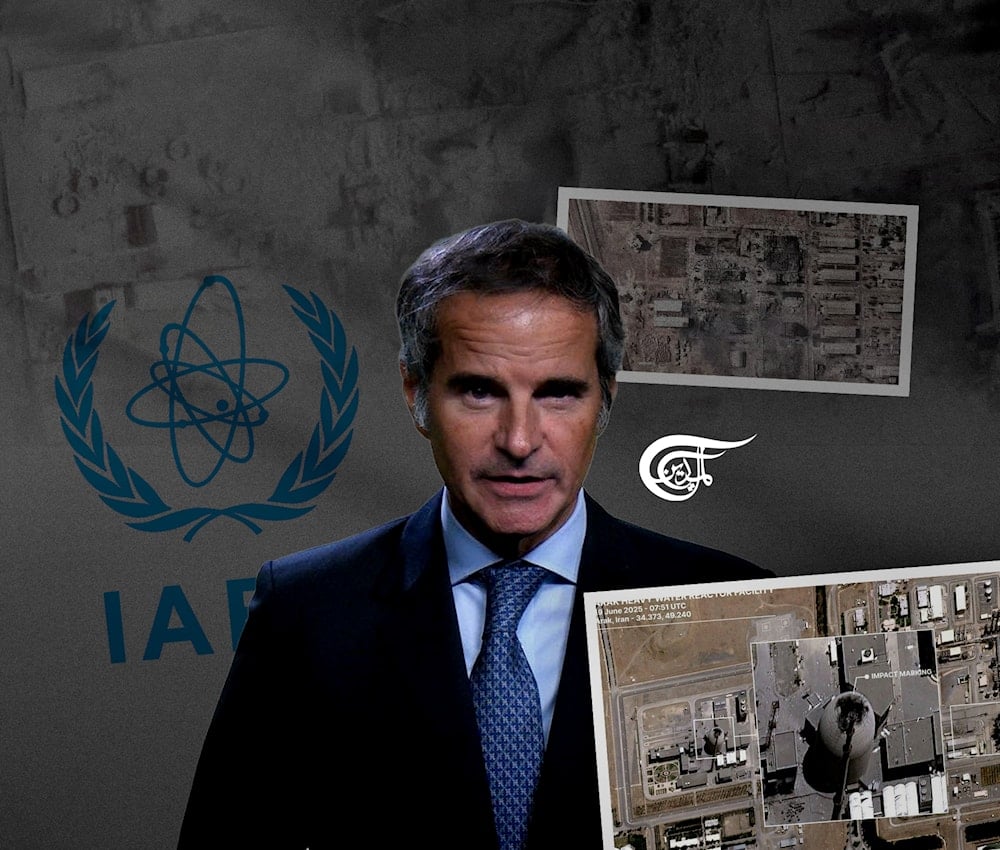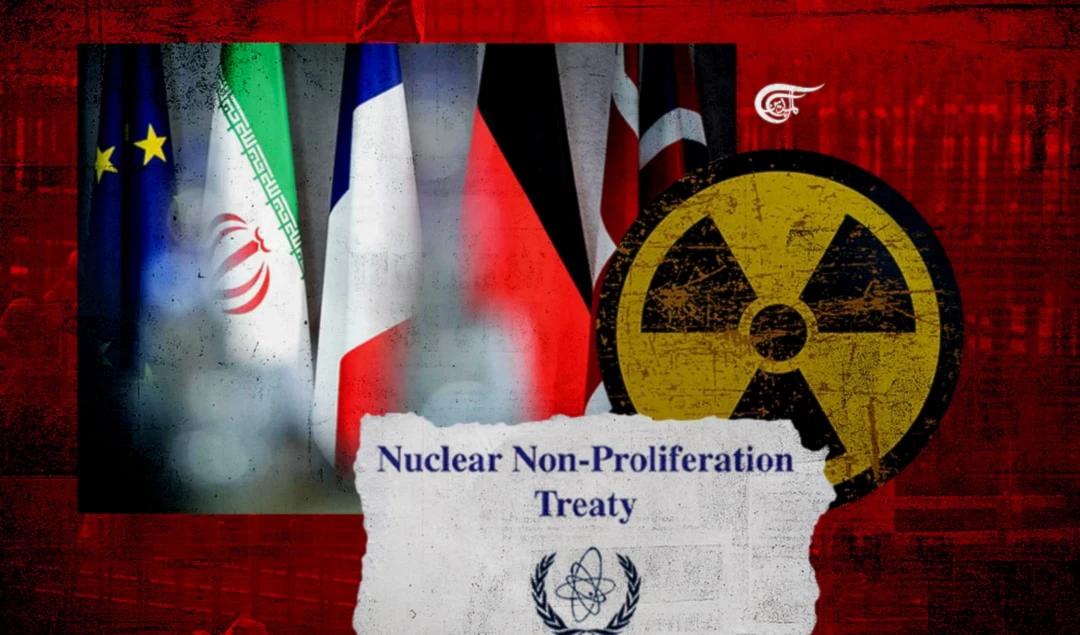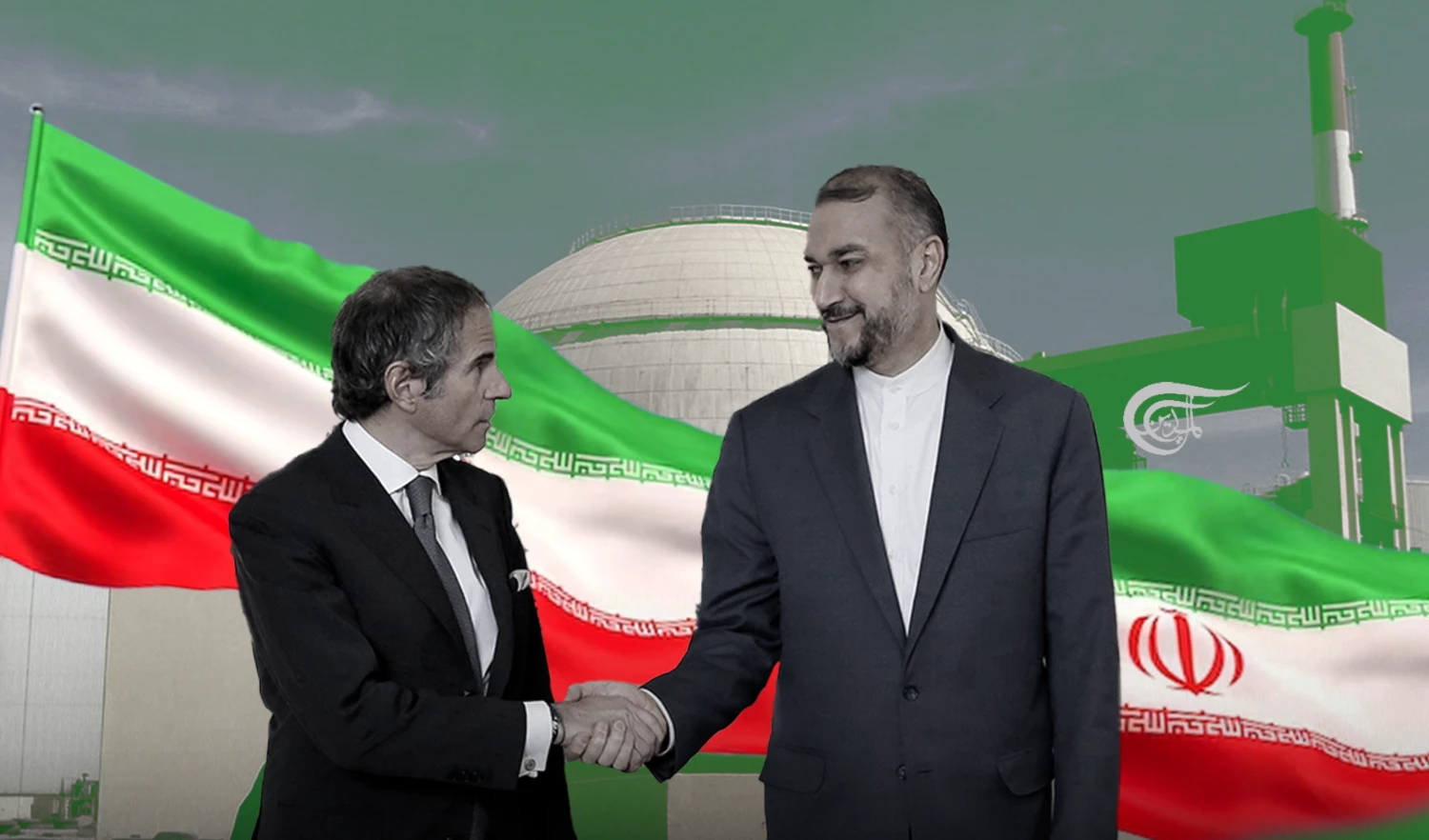Spying for enemies: Beware ‘intergovernmental’ organizations
Leaked documents suggest the IAEA helped Israel target Iranian nuclear scientists, deepening Tehran's distrust of Western-linked international organizations.
-

Under the terms of Tehran’s July 2015 deal with the Obama administration, for years the IAEA was granted sweeping access to Iran’s nuclear complexes, to ensure the Islamic Republic was not using the facilities to develop nuclear weapons (Illustrated by Mahdi Rteil to Al Mayadeen English)
On June 13th, the Zionist entity carried out an unprovoked, criminal military strike on Iran. While its impact was limited, with Tehran’s counterattack far more devastating, the Israeli targeted assassination of a number of Iranian nuclear scientists indicates Tel Aviv knew their identities and locations. Coincidentally, a day prior to the entity’s broadside, Press TV published documents indicating that the International Atomic Energy Agency had previously provided Israeli intelligence with the names of several Iranian nuclear scientists, who were subsequently assassinated.
Other documents indicate that IAEA chief Rafael Grossi enjoys a close, clandestine relationship with Israeli officials, and has frequently acted upon their orders. The files are part of a wider trove obtained by Iran’s Intelligence Ministry, containing unprecedented insights into Tel Aviv’s secret, illegal nuclear weapons capability, and its relationships with Europe, the US, and other countries, among other bombshell material. The tranche could well shed further light on the IAEA’s brazen, murderous collusion with the entity.
Further reinforcing interpretations that the IAEA assisted in the Israeli June 13th strike on Iran, a day prior, the Association’s Board of Governors declared Tehran “in breach of its non-proliferation obligations.” The basis for this finding, which provided Tel Aviv with a propaganda pretext for its illegal attack, was an IAEA report published two weeks prior. The document provided no new information - its dubious charges related “to activities dating back decades” at three sites where allegedly, until the early 2000s, “undeclared nuclear material” was handled.
Under the terms of Tehran’s July 2015 deal with the Obama administration, for years the IAEA was granted sweeping access to Iran’s nuclear complexes, to ensure the Islamic Republic was not using the facilities to develop nuclear weapons. Association inspectors collected vast amounts of information on and within the sites, including surveillance camera photos, measurement data, and documents. The question of whether this yield was shared with the Zionist entity, and in any way assisted its June 13th strike, is an open and obvious one.
Despite the prospect of war erupting between Iran, the Israelis, and its Western puppet masters, US President Donald Trump has expressed optimism he can both broker peace between Tehran and the Zionist entity, and finalize a new nuclear deal with the Islamic Republic. Both outcomes seem highly implausible. At the very least, there is little chance of IAEA inspectors being permitted anywhere near Iran’s nuclear sites again, given the Association’s intimate covert relationship with officials in Tel Aviv, and complicity in its attacks old and potentially new.
It behooves states the world over - particularly those in the crosshairs of the Empire, and its assorted proxies and puppets - to think twice before granting entry to representatives not merely of the IAEA, but a panoply of supposedly neutral, international, intergovernmental organizations. Especially if they seek access to sensitive information and installations. It is almost inevitable any intelligence gleaned from such operations will be shared, to the immense detriment of the countries and governments that have allowed these entities access to their soil.
‘Very Precise’
Founded in 1975, the Organization for Security and Cooperation in Europe is an intergovernmental entity with member states hailing from Asia, Europe, and North America. The world over, its monitors oversee elections and human rights compliance by foreign governments, and are frequently posted to active warzones and spheres of unrest to keep an eye on events on-the-ground. Its officially stated mission is crisis management and conflict prevention. Yet, OSCE’s activities in Yugoslavia during the late 1990s amply demonstrate its utility for fomenting conflicts.
During the latter half of that decade, Yugoslav authorities engaged in a brutal counterinsurgency against the Kosovo Liberation Army. An Al Qaeda-connected extremist group armed, funded and trained by the CIA and MI6, the KLA sought to construct an ethnically pure “Greater Albania” - a Nazi-inspired irredentist project, uniting Tirana with territory in Greece, Macedonia, Montenegro and Serbia - via insurrectionary violence. Come September 1998, hostilities had erupted into all-out war. A UN Security Council Resolution that month demanded the two sides implement a ceasefire.
Yugoslav military forces were duly withdrawn from the province - in turn, the KLA exploited the army’s absence to intensify its bloody rampage, seizing further territory and purging non-Albanian inhabitants. A dedicated OSCE unit, the Kosovo Verification Mission, was also created to ensure Belgrade’s ceasefire compliance. KVM was granted full, unimpeded movement anywhere they wished locally. Their presence proved pivotal not only to the KLA’s murderous crusade, but NATO’s subsequent criminal bombing of Yugoslavia March - June 1999.
As a May 2000 British parliamentary committee report documented, KVM “started slowly” on October 25th 1998, with only 50 staff. That figure quickly swelled though, with London “[spearheading] efforts to get verifiers on the ground as speedily as possible,” the majority being “military personnel.” Before long, the OSCE mission was 1,500-strong - unmentioned in the report, many KVM observers were intelligence veterans drawn from the ranks of NATO member states, among them a preponderance of CIA spies.
In March that year, The Times exposed how KVM was “swallowed” by the CIA, which pursued an “agenda” making “airstrikes inevitable.” Agency operatives embedded with the OSCE “admitted they helped to train” the KLA, and “undermined moves for a political solution to the conflict” in Kosovo. This included “giving American military training manuals and field advice on fighting the Yugoslav army and Serbian police” to the separatist militia. One CIA operative referred to KVM as “a CIA front”. Another admitted:
“I’d tell [the KLA] which hill to avoid, which wood to go behind, that sort of thing.”
The Times further revealed how before NATO’s bombing of Yugoslavia erupted, “many” of KVM’s “satellite telephones and global positioning systems were secretly handed to the KLA, ensuring that guerrilla commanders could stay in touch with NATO and Washington” throughout the campaign. This extended to “several KLA leaders” having the mobile phone number of US General Wesley Clark, who oversaw the bombing. Moreover, information gathered by OSCE during its mission in Kosovo was pivotal to the destructive operation’s planning.
During Yugoslav leader Slobodan Milosevic’ trial at the International Criminal Tribunal for the former Yugoslavia, numerous defence and prosecution witnesses - including OSCE veterans - testified to KVM’s malign role in laying foundations for NATO’s bombing of Belgrade. A Yugoslav army colonel, suffering severe health issues due to NATO’s illegal use of depleted uranium during the campaign, offered extensive insight into how the Mission’s members would routinely and intensively scout out Yugoslav military facilities, taking comprehensive notes every step of the way:
“The NATO Air Force had very precise…[targeting] data which had been amassed in 1998 and 1999 precisely by members of the verifying commission…[KVM] came to visit [my] barracks very often, very frequently…I would come across them many times taking the coordinates of the facilities and features and drawing maps of the communication network, and they were well-trained…There were a lot of retired officers. They had excellent maps, satellite maps. They had GPS…for automatic determination of coordinates in space over the territory.”
‘Direct Evidence’
Fast forward to March 2014, and OSCE monitors were deployed to Ukraine, as the country’s south and east descended into civil war following the Western-orchestrated Maidan coup. Their presence and role in the conflict was barely acknowledged by the mainstream media at any point during their eight years on-the-ground. They were withdrawn in March 2022, following the outbreak of all-out proxy conflict in the country a month prior.
One might speculate the media’s mass omertà on the OSCE’s activities in Donbass stemmed from their observations completely undermining the official position of multiple Western governments, militaries and intelligence services, Ukraine’s own, and Western news outlets. Namely, that the Donbass civil war wasn’t a Russian invasion, but a brutal crackdown by Kiev on the region’s Russian-speaking population. In October 2018, Alexander Hug, deputy head of the local OSCE mission, was asked by Foreign Policy magazine for his agency’s “official stance on Russia’s involvement.”
Hug said the OSCE had seen “no direct evidence” of this at all. The article was later updated, with Hug revising his answer - he claimed monitors had in fact witnessed “convoys” of an indeterminate nature “leaving and entering Ukraine” at night, “specific types of weapons,” alleged Russian prisoners in custody, and individuals wearing jackets “with the insignia of the Russian Federation.” He nonetheless stressed these could be bought “anywhere”, and he’d also seen military garments bearing the insignia of “Germany, Spain, and others” in Donbass.
It would be unsurprising if these extremely slim pickings were served up by Hug to Foreign Policy under duress, by unknown actors. Still, his unrehearsed initial answer is all the more notable given it is now apparent the OSCE mission in Ukraine was heavily compromised and infiltrated. Its observers not only failed to record grave abuses and ceasefire violations by Kiev, but provided sensitive information to NATO and Ukrainian forces.
In September 2023, a British OSCE monitor was sentenced by a Russian court in absentia for providing detailed satellite maps of military installations operated by the breakaway Lugansk People’s Republic to NATO. This espionage allowed Ukrainian forces to carry out attacks on these sites, resulting in personnel casualties and material damage. Greece’s former ambassador to Kiev has alleged such intelligence sharing was routine. It has also been alleged a Russian OSCE observer was assassinated in 2017, explicitly to remove them from the mission.
Iran wisely is not a member of the OSCE and does not allow its “observers” access to its territory. Nonetheless, the Organization has taken a keen interest in Tehran’s bogusly alleged nuclear weapons program. In June 2012, an OSCE delegation declared, “we can no longer ignore the international security implications presented by a nuclear Iran.” It further noted Iran borders OSCE members Armenia, Azerbaijan, Turkey, and Turkmenistan, suggesting they could somehow assist in neutralizing the Islamic Republic’s purported nuclear ambitions.
Given the bombshell disclosures about the IAEA’s collusion with the Israelis, and deplorable track records of fellow UN-affiliated “intergovernmental” organizations such as the OSCE, it is inconceivable Tehran shall be willing to permit any international entity to play a role in mediating its conflict with the Israeli regime. All non-Western countries would be wise to follow their lead.

 Kit Klarenberg
Kit Klarenberg
 10 Min Read
10 Min Read











